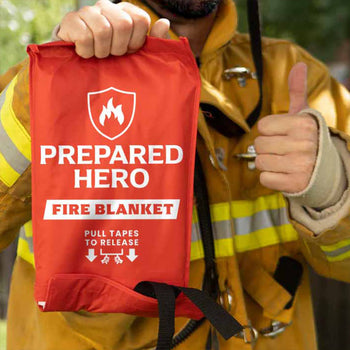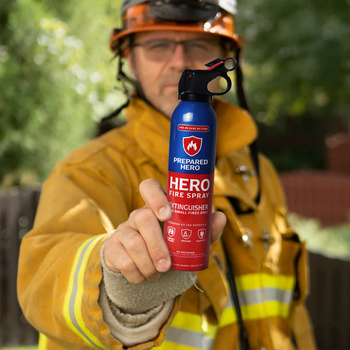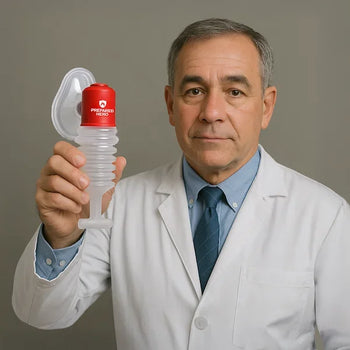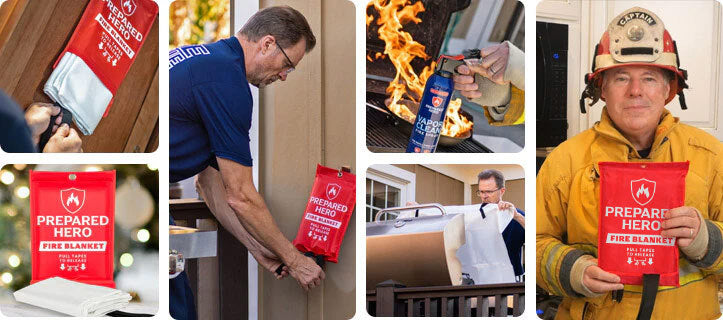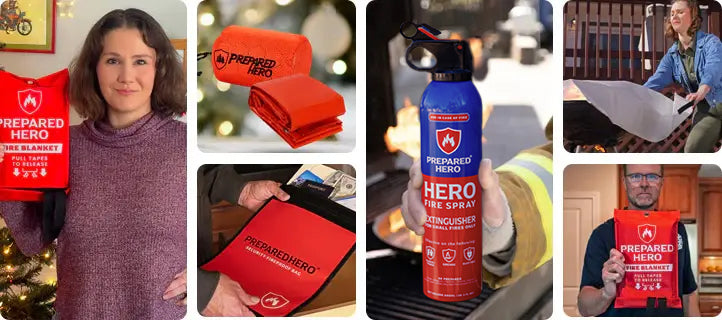Where you put your smoke detectors matters just as much as installing them. Proper placement makes sure they can detect...
Physical hazards are everywhere, whether you're at work or relaxing at home. They can cause serious injuries, chronic health issues, and death if we’re not careful.
In this guide, we’ll break down the four types of physical hazards. We’ll explain each physical hazard and how they affect you. We’ll also share how to identify them so you can stay safe, happy, and productive. By being aware and taking a few steps, we can create safer environments for everyone.
What Are Physical Hazards?

According to the National Institute for Occupational Safety and Health, physical hazards are agents, factors, or circumstances that can cause damage through contact. In other words, they can cause physical harm or injury to people. They can come from materials, equipment, or the building’s layout.
Physical hazards are among the leading causes of injuries in many industries. More risky industries like mining and construction tend to have more physical hazards. Physical hazards also exist at home, even though many people are less aware of them.
Over time, people have developed safety practices to manage physical hazards. These practices help reduce the harmful effects of physical hazards. Technology greatly helps, with advancements in the safety space protecting millions of homes and workplaces.
Why Are Physical Hazards Dangerous?

Physical hazards are hiding in plain sight, and they can pose many risks to your safety and well-being. From heavy machinery to slippery floors, physical hazards can lead to injuries, health issues, and more. Understanding how dangerous physical hazards are helps people create safer environments, save lives, and protect properties. Here are the reasons why physical hazards are dangerous:
Injuries
Physical hazards can lead to cuts and fractures. For example, if you’re working with huge machines without proper safety gear, you could easily get injured. Think about a construction worker who gets too close to a moving crane—one wrong move, and it’s game over. Even a wet kitchen floor can cause a nasty fall, leading to injuries that can last for months.
Physical hazards also create unsafe environments. For instance, a pantry stacked with boxes can hurt people if one tumbles down. Similarly, spills on a factory floor can cause workers to slip and fall.
Health Issues
The negative effects of physical hazards aren’t one-time deals; they can have lasting effects. For example, working in a noisy factory without ear protection can lead to hearing issues in the long run. Plus, if you’re lifting heavy loads without the right support or form, you can develop chronic back pain, muscle pain, or other issues. These health issues might seem mild at first, but they can become lifelong issues that affect your everyday life.
Psychological Effects
Working or living in a hazardous environment can mentally drain you. Think about living in a house with ongoing construction—exposed wiring, incomplete walls, and piles of tools. The constant stress of worrying about tripping and getting electrocuted can affect your mood and well-being.
The same thing applies to workers in a restaurant. Cluttered pots, sharp knives, and slippery floors create a hazardous environment. Chefs and staff constantly worry about burns or cuts while rushing to cook food. The constant stress can lead to anxiety, burnout, and lower morale, making it difficult to do their jobs.
Financial Burdens
Physical hazards can mess with workflows and result in employee downtime. For instance, a machine can break down in a factory due to a lack of maintenance. Production will be disrupted for hours or days, resulting in delays that can affect the company. Plus, workers in unsafe environments will likely be absent, which strains the factory’s operation.
Legal Consequences
Physical hazards can also lead to legal troubles. If a worker gets injured on the job because there are no safety protocols, the company might face lawsuits, pay hefty fines, and get penalized. In worse cases, the government might suspend or permanently shut down the company. For example, a factory might have to pay for lost wages, medical bills, and higher insurance premiums if a worker gets injured because the company didn’t provide safety gear.
Four Types of Physical Hazards

Understanding the types of physical hazards helps you create safety protocols that can save lives and protect properties. Here are the four types of physical hazards:
Extreme Temperature
Extreme temperature is the first type of physical hazard. According to the ILO (International Labor Organization), extremely hot and cold temperatures threaten people’s health and safety.
Extreme heat can cause heat stroke, exhaustion, cramps, rashes, and even death. It can also affect people’s cognitive function and productivity. Plus, extreme heat, a component of the fire triangle, can start a fire and make it spread quickly.
On the flip side, extreme cold can lead to many health issues like frostbite, hypothermia, and trench foot. This is more common for people who have to be out for extended periods during the winter when the temperature goes below 0°C.
Remember, when the temperature becomes too low or too high for people to stay safe, that’s a physical hazard. How you manage the temperature at your house or workplace depends on the normal temperature and what’s indoors or outdoors. The OSHA (Occupational Safety and Health Administration) recommends setting an office’s temperature to 68°F-76°F and the humidity to 20%-60%.
Working outdoors also has effects on an employee’s safety. The effects might be quick or develop over the years, depending on the situation. Hence, workers exposed to extremely cold or hot temperatures should have safety gear, protective clothing, and proper hydration. For instance, forest rangers should bring survival bags and survival ponchos, while welders should have fire protection gloves and fire blankets.
Noise
Noise refers to unwanted sounds that create problems at home or in the workplace. It’s considered a physical hazard because it can harm people over time. When you're exposed to loud noise for long periods, your hearing will likely get damaged. This doesn’t happen overnight but builds up slowly. Plus, people often don’t notice it until they’re older.
Let’s look at a case study by the International Labor Organization as an example. The case study involves a worker at a metal-cutting guillotine with noise levels up to 92 decibels (dB). That’s extremely loud—comparable to a rock concert. After fixing things like servicing the machine and adding carpet to reduce noise from falling metal, the noise level dropped to 83 dB.
So why should we care about noise? For one, noise can lead to permanent hearing loss that makes everyday activities tough. Think about struggling to follow conversations or not hearing the phone ring. Noise can also cause issues like tinnitus, the annoying ringing in the ears that disrupts sleep.
In addition, noise makes it harder to communicate. It’s risky if household members or workers can’t hear warnings or important instructions. Imagine not hearing about a fire warning in a factory filled with paper.
You can reduce noise by relocating noisy machines away from workers, investing in quieter equipment, or putting physical barriers to block the sound. Rearranging the workspace’s layout to avoid noise also helps. Employers should also provide hearing aids and protection to employees whose hearing started to decline. However, this should be a last resort because employers should prioritize reducing noise.
Regular hearing checks should also be done if the noise level is high. Doing so ensures that the hearing damage is caught early. Remember, taking noise seriously protects people’s hearing and makes the workplace safer and more efficient.
Radiation
According to the International Atomic Energy Agency, radiation is energy that travels through space. There are two main types of radiation: ionizing and non-ionizing.
Ionizing radiation includes X-rays and gamma rays, which can damage body cells and alter DNA. For example, X-rays are commonly used in medical imaging to diagnose injuries and illnesses. Long-time exposure can lead to burns or increase the risk of cancer. Similarly, gamma rays are used to target and kill cancer cells, yet they can also harm healthy tissues if not used properly.
On the flip side, non-ionizing radiation includes microwaves, lasers, radio waves, and visible light. While generally considered less harmful, they still pose risks. For instance, workers in industries that use lasers need protective eyewear to prevent eye damage. Plus, those working near microwave equipment must take precautions to avoid burns from heat exposure.
Radiation protection helps workers stay safe without limiting its benefits in industries like medicine and manufacturing. Keeping workers safe is the priority, and effective radiation management is key to achieving that.
Vibration
Vibration is a physical hazard that can seriously impact workers' health. There are two main types: whole-body vibration (WBV) and hand-arm vibration (HAV).
Whole-body vibration occurs when a person is seated on a vibrating surface, like when operating heavy machinery or riding off-road vehicles. On the other hand, hand-arm vibration happens when workers use vibrating tools, like jackhammers or powered lawnmowers, which transmit vibrations through their hands.
Short-term exposure to vibration might lead to temporary discomfort. However, constant, prolonged exposure can cause permanent damage. For example, HAV can result in Hand-Arm Vibration Syndrome (HAVS). This causes numbness, reduced strength, and poor circulation. On the other hand, WBV can cause back pain, which can be made worse by poor posture and manual handling.
A case study by the ILO revealed that workers in a foundry setting were exposed to vibration while using powered hand-held tools. Switching to a new casting process eliminated the need for heavy tool use. The exposure to vibration was reduced, and the foundry became more efficient. Their manufacturing expenses also went down.
Employers need to implement vibration control measures and provide training. These include using vibration-dampening tools, regular maintenance, or redesigning workflows to minimize exposure. By dealing with vibration hazards, companies can protect workers from painful and disabling conditions while keeping productivity high.
How to Identify Physical Hazards

Hazards can come from all sorts of things, including machines and tools. Taking time to spot these hazards can save lives and prevent messy lawsuits. Here’s how to identify physical hazards:
Understand What Physical Hazards Are
Physical hazards are things that can cause harm through contact. This could be the noise from machines, vibration from handheld tools, or heat from working in the field. Familiarize yourself with the hazards specific to your workplace or home. Remember, different environments, like factories and kitchens, have unique hazards.
Inspect the Area
Go around your house or workplace to identify potential hazards. Look for heavy machines that produce too much noise, tools that vibrate too much, and the like. Pay attention to how people use such equipment and how safe they are when doing so.
List Down Potential Hazards
Next, list down the potential hazards you saw. These lists can highlight common hazards like noise levels, radiation exposure, or extreme heat. Checklists help keep you organized so you don't overlook anything.
Let People Participate
Ask others to share their thoughts on physical hazards they’ve encountered. For example, employees can share valuable insights based on their daily experiences, which you might miss during inspection. Creating an open environment where workers feel comfortable reporting concerns helps improve workplace safety.
Review Safety Protocols
Review current safety protocols to determine if they are effective. Are there clear guidelines for dealing with noise or exposure to radiation? Does the company provide protective gear? Then, see whether employees know these protocols and if they’re implemented. Regular reviews help identify gaps in safety measures.
Reassess Regularly
Physical hazards can evolve with changes in equipment, personnel, or workflow. Regular reassessments help safety protocols evolve, too. This proactive approach identifies new physical hazards and makes sure they’re handled properly.
Document Your Findings
Keep detailed records of physical hazards and all actions to reduce their effects. Doing this helps track improvements and serves as a reference for future safety training sessions. This also makes people more accountable and provides a clear history of safety efforts at home or in the workplace.
Conclusion
Managing physical hazards is about being proactive and staying aware. Whether you're at work or home, being vigilant goes a long way in preventing accidents and injuries.
By regularly checking your surroundings, involving others in safety discussions, and keeping up with safety protocols, you create a safer environment for everyone. Remember, it’s not just about following rules—it’s about looking out for each other. Stay prepared, hero!


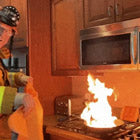 Fire
Fire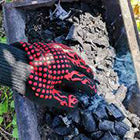 Safety
Safety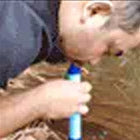 Survival
Survival Protection
Protection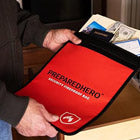 New
New Scouting America
Scouting America
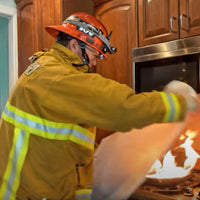 Fire
Fire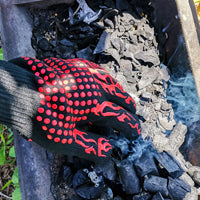 Safety
Safety Survival
Survival Protection
Protection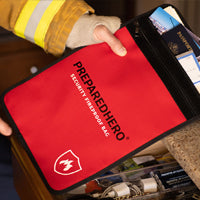 New
New
